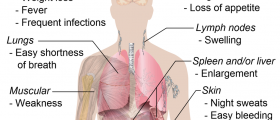White blood cells, also known as leukocytes, are the most important constituents of the human immune system. These tiny cells help our bodies to fight infections. In a body of a healthy adult, there are 4,000 to 10,000 white blood cells per micro-liter of blood. Carried by the bloodstream, these protective cells travel all around the body and react against harmful invaders.
Whenever a regular blood test shows increased levels of white blood cells, that is a strong indicator there is an infection occurring somewhere in the body. All of the leukocytes are produced from a multipotent cell in the bone marrow known as a hematopoietic stem cell. There are five different types of leukocytes: neutrophils, eosinophils, basophils, monocytes, and lymphocytes.

Drastic change in the number of white blood cells, which may affect the overall white cell count or one of the specific populations of white blood cells, is often an indicator of different diseases or disorders.
Neutropenia
Neutropenia is a hematological disorder distinguished by an abnormally low number of the most important type of white blood cells - the neutrophils. Normally, neutrophils are presented in 58% of a blood unit. A normal level of neutrophils per blood unit ranges somewhere from 50 to 70 percent. These cells serve as a primary defense against infections. When a white blood cells count drops under this level, patients become more susceptible to bacterial infections.
- Healthy Caucasian and Asian populations generally have ANCs of 1.5 to 7.0 × 109/L. Persons of African descent, however, often have lower normal neutrophil counts, with ANC
- Neutropenia can be described as transient (or “acute”) or chronic (or “persistent”); extrinsic or intrinsic; by descriptive names (e.g., neonatal isoimmune neutropenia of infancy, cyclic neutropenia, severe congenital neutropenia) and as syndromes (e.g., Kostmann, Shwachman-Diamond, and Barth syndromes). The discovery of the diverse causes for the congenital neutropenias now permits genetic diagnosis in many cases.
- Nutritional deficiencies of vitamin B12, folic acid or copper, or severe protein-calorie malnutrition can cause neutropenia. These deficiencies almost always cause multiple cytopenias rather than isolated neutropenia and are usually diagnosed based on medical history, physical examination and laboratory measurements of specific vitamin levels.
- Chronic autoimmune neutropenia of infancy and early childhood is a relatively common disorder and virtually always runs a benign course, despite very low ANCs. It usually resolves spontaneously by age 3–5 years, with a mean duration of 17 months.
- Fever in the setting of profound neutropenia is a medical emergency requiring immediate treatment with broad spectrum antibiotics. Patients with ANC of 0.2 × 109/L or less almost invariably require hospital admission for IV antibiotics, with the choice of drugs depending upon local community and/or hospital flora and antibiotic sensitivities. Importantly, antibiotic therapy should include anaerobic coverage when fever is accompanied by abdominal pain, as may recur frequently in cyclic neutropenia.
- Patients with an ANC 0.2 × 109/L usually require admission, but culturing and out-patient antibiotics may be used for some with more benign forms of neutropenia, such as chronic autoimmune neutropenia of infancy, with relatively good delivery of neutrophils to tissues sites of infection.
- Hematopoiesis is regulated by a family of hematopoietic growth factors; the myeloid-specific cytokine granulocyte colony-stimulating factor (G-CSF) is the principal regulator of the blood neutrophil count. Recombinant human G-CSF (filgrastim; Neupogen®, Amgen, Inc., Thousand Oaks, CA) is now widely used to stimulate neutrophil production in patients with chemotherapy-induced neutropenia. It is also very useful for management of severe chronic neutropenia, with slightly different principles governing its administration.
In most severe cases, a dangerous condition of neutropenic sepsis may occur, and the result may even be fatal. Neutropenia usually results from problems in the production of the cells by the bone marrow or the destruction of the cells elsewhere in the body.
HIV/AIDS
AIDS is short for acquired immunodeficiency syndrome, a chronic systematic disease caused by the human immunodeficiency virus, also known as HIV. HIV is a Retrovirus that primarily infects the white blood cells, important for the human immune system.
Once HIV has killed so many white blood cells that there are fewer than 200 of these cells per micro-liter of blood, cellular immunity is lost. When the immune system becomes completely deficient, it loses the ability to fight against infections caused by bacteria, viruses, fungi, and parasites. The resulting symptoms of AIDS are primarily the result of conditions that do not normally develop in individuals with healthy immune systems.
Lymphocytopenia
Lymphocytopenia, also known as lymphopenia is a medical condition characterized by abnormally low levels of lymphocytes in the blood. Lymphocytopenia may occur as a result of pancytopenia when the total number of all types of blood cells is reduced.
The most common cause of temporary lymphocytopenia is a recent infection, such as the common cold, but it may also be associated with the use of corticosteroids, viral infections, malnutrition, hard labor, or chronic stress.
Leukemia
Leukemia is a type of cancer that affects blood or bone marrow. This kind of cancer is characterized by an abnormal increase in the number of white blood cells. Leukemia is commonly characterized by the production of immature white blood cells and a lack of blood platelets.
White blood cells may be suppressed or dysfunctional, causing the patient's immune system to be unable to fight off a simple infection or to start attacking other body cells. Most commonly the disease manifests in frequent infections, ranging from infected tonsils, sores in the mouth, or diarrhea to life-threatening pneumonia or opportunistic infections.






_f_280x120.jpg)









Your thoughts on this
Loading...